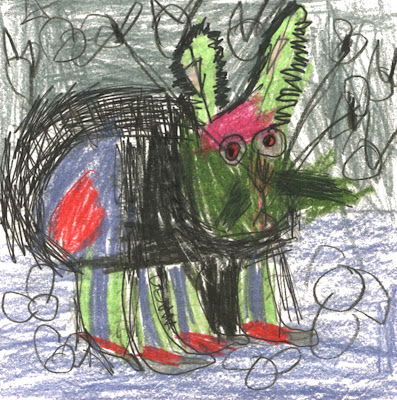“A rabbit feeling scared,” by
Zachary, 5 years young
A peace table is a place where children and adults go to calm, feel, cultivate peace, or
simply be.
Soon after I introduced the
peace table concept a child came up to me and said, “I'm feeling rude inside of
my stomach. Do you think the peace table will help me?” I responded, “It might.
Try it, and see how you feel.”
The child
went to the peace table, put her head on a cushion on the table and took a
trouble doll out of its box. She whispered some words to the doll and put it back
in the box. She later told me that the peace table works.
I situate the peace table in a place where one person can comfortably sit.
I model how to use the table for children. For example, I say out loud, "I'm grouchy. I didn't eat enough breakfast. I'm going to the peace table."
Here are some things to consider placing on your peace table. I do not put all of these things on the table at once. I trade out objects and introduce new ones.
- A cushion to sit on.
- Emotion cards.
- A trouble doll or character in a container. Take the doll and while holding it, tell your troubles (sharing feelings heals). The idea is to give worries to the doll (a practice of letting go).
- Little model characters to tell troubles.
- An old phone book and container. Teach how to tear and crumple one page at a time from that old catalog. Place the crumpled page in the container. Tear as many times as needed (to release feelings such as frustration or anger). Then carry the container to the recycle bin to throw the crumpled papers away.
- A mirror and emotion cards. Teach a child to notice her face and try to connect her feelings with the way she sees her facial expression (to learn about and create a vocabulary for the vast and varied feelings we humans experience).
- Sensory expression. A small brush to brush arms or legs. It's calming to do this for some people.
- Tactile items to move.
- Teach pretend chewing (the movement, not with food) as a way to release anxiety.
- A small pillow. Demonstrate how to kneel and place head on the pillow to calm (like yoga child's pose).
- A stuffed animal to hug.
- A vase with living flowers or fragrant herbs such as basil or mint (to smell, observe, meditate upon).
- Objects from the natural world to contemplate.
- A lava lap to visually soothe.
- Moving water or a small bowl with a goldfish swimming.
- Messages that affirm that all types of feelings are allowed. (Some people say, "Feelings are not facts; they pass.")
